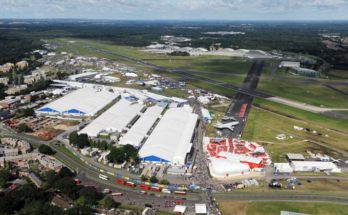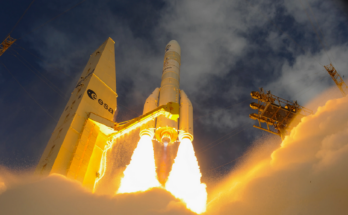
After attending the Satellite 2023 show recently held in Washington, DC, here are the top five topics that stood out.
Neutron on Track; Waterborne Operations Moving Forward
Rocket Lab confirmed that the new Neutron rocket is indeed on track for a 2024 launch. This rocket will be a medium-lift launch vehicle optimized for constellation deployment with a 13,000-kilogram payload to LEO capability. Rocket Lab’s Neutron will be larger than Electron and will be optimized for constellation deployment. As LEO becomes more popular, launch vehicles like these will be needed to bring these large satellite constellations to orbit.
Also discussed at the show was the potential reusability of the Electron rocket. Since the launch vehicle’s inception, reusability has been pursued. Rocket Lab has gone about this in different ways. In contrast to the reusable SpaceX Falcon 9, the booster was initially envisioned as capable of recovery either from the ocean or via helicopter on descent. Through testing, however, it was discovered that the load characteristics on a helicopter were too unpredictable. The company’s CEO, Peter Beck, has abandoned airborne recovery, and instead Rocket Lab will simply pluck the Electron booster from the ocean. Rocket Lab officials at the show said that a booster recovered in this fashion is actually sufficient to reuse the stage.
Electron is a small-lift launch vehicle that launches from Mahia, New Zealand, and now Wallops Island, Virginia. Neutron will be built in Virginia near the launch site.
New Technologies
Ryan Elliott, CEO and co-founder of In Orbit Aerospace, a company exhibiting at the show, remarked that in-space manufacturing is an idea that has a lot of promise. This is not the first time that the theory of space manufacturing has been presented; Thales Alenia Space is working on REV’s REV-1, for example, and experiments on the International Space Station have also been performed.
Mr. Elliott said that a lot can be done in space. Certain metals can only be manufactured in space, and proteins can be grown on a much larger scale for use in the pharmaceuticals industry. Space debris mitigation was also discussed as a possible mission to be carried out in space. In Orbit Aerospace is developing the infrastructure to support in-space manufacturing. The company will build and operate uncrewed orbital platforms, re-entry vehicles, and robotics for cargo transfer and processing. It will also provide the power and data for manufacturers that want to produce much higher-quality or even completely new materials, such as companies involved in the pharmaceutical, semiconductor, fiber optics, 3D bioprinting, and metals and plastics industries.
In Orbit Aerospace could also provide the capability for a wide range of missions such as orbital debris/satellite capture and return (not just removal), space station cargo delivery/return, and precise delivery of cargo from space to Earth for military operations or disaster relief.
SABIA-Mar 1 to Launch in 2024
Argentina’s exhibit at Satellite 2023 was extensive. Among the notable news acquired there is that the country’s SABIA-Mar 1 (Satélites Argentino-Brasileño para Información Ambiental del Mar) satellite will study the oceanic biosphere and how it is affected by human activity. It will study ocean surfaces, the ocean ecosystem, the carbon cycle, and marine habitats, as well as map the ocean. Manufactured by the Argentine company INVAP, the satellite will have a launch mass of about 680 kilograms and will operate in a sun-synchronous orbit.
The satellite is being built under a joint program with Brazil. SABIA-Mar 1 is being built by Argentina, and SABIA-Mar 2 will be built by Brazil. At this time, there is little information about the SABIA-Mar 2, and whether it will even be built is currently unknown. If SABIA-Mar 2 is built, Forecast International expects it will be produced around the end of the decade.
EchoStar to ‘Go LEO’
When I spoke at the show with Rick Lober, vice president and general manager of the Defense and Intelligence Systems Division at Hughes, an EchoStar company, he made clear that EchoStar is “going LEO.” EchoStar is creating a 28-satellite constellation called EchoStar Lyra™ that will operate in the S-band and launch within the next two years. Astro Digital has been tasked with manufacturing the satellites for the constellation, which will deliver global Internet of Things (IoT), machine-to-machine (M2M), and other data services.
EchoStar is looking at another LEO constellation further down the road, but details are limited. Through its Hughes division, EchoStar is also a technology provider to and distribution partner of LEO operator OneWeb. There is a current rush within the space community for LEO constellations. These low-Earth-orbit constellations do have their drawbacks. Because the Earth is 70 percent covered by water, a large number of the satellites in these constellations are not being used at a given time as they orbit the Earth. Therefore, it is important, according to Mr. Lober, that GEO, LEO, and even MEO satellites can be used together to draw on the strengths of each. EchoStar has numerous GEO birds, and utilizing these with new LEO architecture is paramount to staying competitive moving forward.
Satellite Safety as Important as Ever
As low-Earth-orbit satellites become increasingly popular, tracking objects in space will grow in importance. Vyoma is a company that has entered this field of tracking. The Germany-based company has partnered up with ground-based sensor networks, located around the globe, to perform tracking of satellites and space debris. Moreover, the company will launch a small fleet of space telescopes to track objects from space directly, which will bring space intelligence and data in real time to the space community. The ability to track space objects in real time increases the safety of assets in orbit, as more frequent observations translate into very accurate determination of the positions of these objects.
As a result, Vyoma can predict trajectories of objects so customers can make informed decisions in regard to moving their own space assets. The company also offers space traffic management services, such as automated collision avoidance and detection of close approaches. With thousands of satellites launching yearly, LEO will only become busier. Tracking companies such as Vyoma will grow in importance. Mitigating risk is key, but knowing when moving a bird is unnecessary is also vital. In-orbit maneuvering burns precious fuel that can decrease the lifespan of a particular satellite and interrupt the services being provided by a satellite, both reducing the revenues of satellite operators and preventing access to people who depend on these services from Earth (think navigation or agriculture monitoring). During my conversations with Vyoma at the show, its representatives and I agreed that space tracking and its importance cannot be overstated.
Forecast International’s Space Systems Forecast – Satellites & Spacecraft product covers communications, remote sensing, scientific, and navigation spacecraft. Individual reports detail the markets for commercial networks like Intelsat and military systems such as the SBIRS constellation. Satellites covered range in size from small CubeSats to large platforms like the Boeing-702 and SSL 1300. The service also features reports on new market entrants like Planet of San Francisco and OneWeb. Click here to learn more.
Carter Palmer has long held a keen interest in military matters and aviation. As a FI's space systems analyst he is responsible for updating the reports and analyses within the Space Systems Forecast – Launch Vehicles & Manned Platforms and Space Systems Forecast – Satellites & Spacecraft products.




